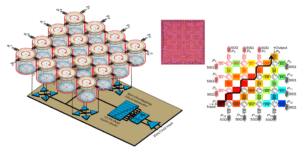Posted on June 1, 2022 in ASRC News, Featured News, Photonics Initiative
Topological insulators are materials that conduct electricity on their surface but behave like insulators on the inside. Their potential is so enormous that a group of scientists who made theoretical discoveries using topological concepts won the Nobel Prize in physics in 2016.

A new paper published last month in the journal Nature Electronics presents an electromagnetic topological insulator on an integrated chip — the first of its kind ever implemented. Co-author Andrea Alù, founding director of the Photonics Initiative at the Advanced Science Research Center at the CUNY Graduate Center (CUNY ASRC), and professor of physics at the Graduate Center, described it as “an exciting discovery in the field of photonic topological insulators.”
“Our demonstration extends by orders of magnitude the bandwidth of operation, and at the same time significantly scales down the footprint of a photonic topological insulator, paving the way to extremely compact broadband, highly-reconfigurable, non-reciprocal components based on topological matter,” Alù said.
The team was able to produce non-reciprocal and topological wave phenomena on a standard integrated chip without the need for exotic materials, while scaling down in size compared to other demonstrations on different platforms, Alù said. Topological insulators with non-reciprocal properties can guide light waves in one direction, and they’re highly resistant to defects and irregularities on their surface.
In their experiments, the team was able to demonstrate how their topological insulator could be practically used in 5G wireless systems, including multiantenna, full-duplex wireless communications, and radar systems.
The team of researchers included Aravind Nagulu of Washington University in St. Louis, and Harish Krishnaswamy of the CoSMIC lab at Columbia University. The project was supported by the Air Force Office of Scientific Research MURI program, the Defense Advanced Research Projects Agency (DARPA) SPAR program, the Office of Naval Research, and a Vannevar Bush Faculty Fellowship from the Department of Defense.
